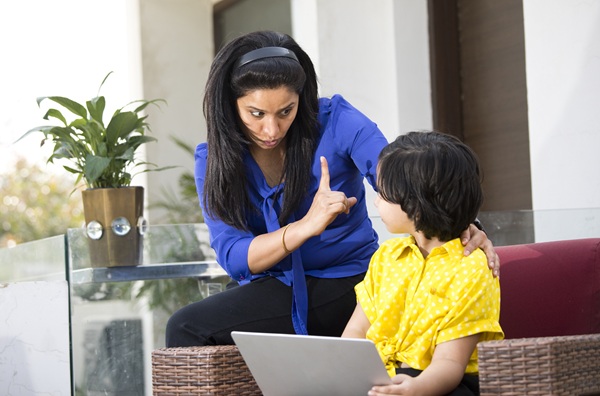.png)
It Takes a CEO to Raise a CEO
Parenting is emotional governance. By choosing empathy over reactivity, you raise not just a child, but tomorrow’s resilient leader.


By Kirti Tarang Pande
Kirti Tarang Pande is a psychologist, researcher, and brand strategist specialising in the intersection of mental health, societal resilience, and organisational behaviour.
September 6, 2025 at 8:13 AM IST
Heal before you lead. Connect before you correct.
Your neighbour texted. Her son is injured because of your seven-year-old’s “bike crash” game (and it’s not the first time! It reflects a pattern of rough play despite his friend’s repeated ‘no’s). She’s pleading for children’s safety.
What would you do?
A. Scold, punish, lay down the law.
Or,
Then you thank your neighbour for bringing it to your attention.
You engage with your child with empathy, not accusation:
“Your friend got hurt. How are you feeling?”
You listen. You validate:
“I know you didn’t mean to harm him.”
And then, you state the truth:
“But ‘no’ means no. You breached consent. How will you repair this?”
You don’t lecture. You engage in a strategic dialogue to architect empathy and problem-solving:
“Before a rough game, how will you ensure safety and consent?”
You guide:
“Ask. Set rules. If they say no, you stop. Always.”
You teach how to make amends:
“Your friend is hurt. How will you show you’re sorry for ignoring his ‘no’?”
Finally, you redirect:
“Your energy is good; its outlet needs safety. We’ll practise together. Crash into pillows, not people.”
If you chose D, you didn’t just choose parenting. You chose leadership development: by governing your own reactivity first, you architected their empathetic problem-solving.
Most of us know, (at least theoretically), that D is the “right” answer. It’s the Authoritative Model—psychology’s gold standard for parenting. Because it uses connection before correction to ensure the child feels safe and understood, and it validates their feelings to reduce their defensiveness (like lying). Rather than relying on punishment, it focuses on collaborative problem-solving to build intrinsic motivation and empathy. Finally, it models and scaffolds desired behaviours by providing supervised practice and safe alternatives, essential for internalising new skills and shaping prosocial personality traits. It’s the ultimate ‘CEO maker’ model.
These four responses are a diagnostic toolkit, not isolated reactions. They map to core parenting archetypes:
A is Authoritarian and Punitive: the “Because I said so!” style, ruled by anger and fear.
B is Permissive and Performative: the “Just say sorry with chocolate” style, which looks for a quick fix, transactional appeasement, and generates fake peace.
C is Avoidant: the “Let’s not talk about it” style, which ignores the real issue by externalising the blame.
But D is Authoritative: the “Let’s figure this out together” style. It’s firm but fair. It gives the child a voice, respects their feelings, and teaches them how to make things right (not because they’re forced to, but because they want to). Because the parent understands that while rules without relationship feel like prison, rules with relationship feel like protection.
Reactive Defaults
But let’s be honest. How many of us consistently choose D?
We default to A, B, or C for the same reason teams silo information and projects fail: reactivity. We are not leading; we are refereeing. We are managing behaviour, not cultivating character.
I remember, once a parent shared that they hit their child ‘when they don’t listen’ and supported it as their right to choose their parenting style. Fair enough! As a psychologist, it’s my duty to value-bracket (not force my ‘hitting a child is technically child abuse’ value-system on them); but it is also my ethical responsibility to highlight the consequences of their choices.
We have years of scientific data demonstrating that a child raised on punitive parenting (A) becomes either an authoritarian leader or a passive subordinate (both are low on trust and high on anxiety). The performative apology (B) teaches that relationships are transactional, creating adults who lack accountability. Avoidance (C) breeds executives so conflict-averse they’ll rather watch a project burn than have a difficult conversation.
These children are your future workforce, your market, your policymakers. Your parenting approach to conflict resolution today fundamentally shapes their capacity for empathy, resilience, and collaboration. Your parenting style isn’t just a domestic concern; it’s a macroeconomic variable. It determines the quality of your retirement and the safety of your grandchildren’s world.
If we all know that Option D is the best, then why do we fall short of practising it? It’s definitely not the lack of motivation. Because when we imagine what kind of parent we want to be, we visualise ourselves as calm, empathetic, and validating. Someone who models and scaffolds right behaviour and makes problem-solving a collaborative process. When we see the barely baby-like shape in sonography, we don’t imagine ourselves yelling, punishing or hitting that child, or being performative or avoidant. Then what goes wrong?
The answer lies in the first sentence of option D: “You govern yourself first.” It is the applied truth of Viktor Frankl’s existential psychology: “Between stimulus and response, there is a space. In that space is our power to choose our response. In our response lies our growth and our freedom.” It highlights the human ability and responsibility to pause and choose how to respond. That ‘space’ is where growth lives. That ‘space’ is where you choose your legacy.
Again, this isn’t new to us. We know there should be a pause that gives us freedom to choose a response rather than acting like a slave to a situation. Yet, we often fail. Why?
Because we are not the CEOs (Chief Emotional Officer) of our own life! So, how do we become one? In Patanjali Yogasutram, focus on anushasanam in the very first sutra “atha yoga anushasanam”. Anu means self and shasanam means governance. The sutra means, “now begins yoga, which is self governance.” Because when you practice to calmly focus on your breath even when your body is twisted, you train yourself in finding stillness—not in absence of struggle, but within it.
That is the ultimate Chief Emotional Officer skill.
So, must you master a headstand to master the pause? Hardly. The yoga mat is just one training ground for self-governance. The real work is in cultivating self-awareness. And no, that doesn’t mean endless journaling or forced meditation.
There’s a more compelling way: live your own life. Pursue your dreams. Resolve your regrets. Heal your emotional debts. Because when you don’t, you silently outsource your baggage to your child. You avoid the pause (the space between impulse and action) because that quiet forces you to face what you’ve buried. You fail to pause because that silence is uncomfortable. It holds up a mirror—it shows your own unresolved self, your impatience, your need for control, your unlived life.
That’s why you stay reactive instead of responsive. Why you parent from your shadow, not your strength. You can’t raise a future CEO if you’re not the Chief Emotional Officer of your own life. You cannot teach a child self-regulation you do not practice. You cannot foster innovation in your company if you stifle it in your home. The skills are identical: emotional intelligence, conflict resolution, resilient problem-solving.
While a child’s personality and behaviour are shaped by multiple factors, we owe them the most conducive environment (to the best of our knowledge) for development. This isn’t about becoming a perfect parent. It’s about becoming an integrated leader. The same way you audit a company’s culture, you must audit your home’s emotional architecture. Are you building resilience or compliance? Are you fostering collaboration or submission?
As Carl Jung warned: “The greatest burden a child must bear is the unlived life of the parents.”
Your child doesn’t need a perfect parent. They need one brave enough to live.



